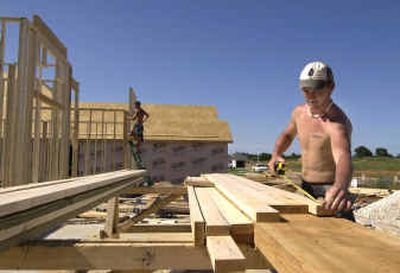Housing construction slows down

WASHINGTON – Home builders took a breather in June, sending housing construction down to its lowest level in just over a year. It was another sign the economy slowed down last month.
The number of housing projects launched by builders clocked in at a seasonally adjusted annual rate of 1.80 million units, an 8.5 percent drop from May’s level, the Commerce Department reported Tuesday.
Although the 1.80 million pace was the lowest since May 2003 and was weaker than economists expected, it still represented a respectable level of activity, analysts said.
Housing construction in May rose by 0.4 percent from the previous month, according to revised figures. That turned out to be stronger than the decline previously estimated.
Tuesday’s report is consistent with other economic data — including retail sales, the nation’s employment situation and industrial production — that suggested the economy hit a rough patch in June. Analysts, however, are confident that’s just a temporary lull, rather than a sign of trouble ahead for the economic recovery.
“The builders, God bless their hearts, may have gotten a little bit cautious in June, reacting to all the hype about what the Fed was going to do with interest rates,” said David Seiders, chief economist at the National Association of Home Builders.
At the time, there was speculation as to whether the Federal Reserve would raise interest rates by a modest one-quarter percentage point or a bolder, half-point move, said Seiders, whose industry is sensitive to interest rate changes. Mortgage rates had moved up in the middle of June in anticipation of Fed action. But in recent weeks, mortgage rates have been falling.
Fed policy-makers on June 30 boosted interest rates for the first time in four years by one-quarter point to 1.25 percent from a 46-year low of 1 percent, a move aimed at keeping inflation at bay. The Fed’s action pleased investors.
Fed Chairman Alan Greenspan, in an appearance Tuesday on Capitol Hill, offered a fairly upbeat assessment of the economy and suggested the softness seen in recent consumer spending “should prove short-lived.”
On Wall Street, Greenspan’s comments lifted stocks. The Dow Jones industrials gained 55.01 points to close at 10,149.07.
But most major homebuilding companies’ stocks slid, losing around 3 percent at midday and then recovering slightly later in the afternoon.
On the NYSE, shares of Centex Corp. fell 58 cents, more than 1 percent, to close at $41.95; Pulte Homes Inc. lost 65 cents, more than 1 percent, to close at $51.40; K.B. Home fell 83 cents, more than 1 percent, to close at $65.21; Toll Brothers Inc. fell 33 cents, nearly 1 percent, at $39.34; and Lennar Corp. slipped 23 cents, or 0.5 percent, to close at $42.23.
Residential homebuilder D. R. Horton Inc. fared well compared to its competitors, settling up 23 cents, or nearly 1 percent, at $26.25 on the New York Stock Exchange.
Greenspan said the drop in housing construction last month was no cause for worry. “We don’t perceive the June figure to be a harbinger of worse to come,” he said.
Seiders and some other economists predict housing starts will rebound in July. They believe housing construction — a powerhouse over the last several years— will remain in good shape, but probably will gradually slow through this year.
In Tuesday’s report, housing construction fell across all regions of the country.
The number of housing units builders started in the Northeast last month fell by 3.5 percent to a seasonally adjusted annual rate of 165,000. In the Midwest, housing activity declined by 11.5 percent to a pace of 315,000. In the South, housing starts went down by 3.1 percent to a pace of 846,000, and in the West they dropped by 16.5 percent to a pace of 476,000.